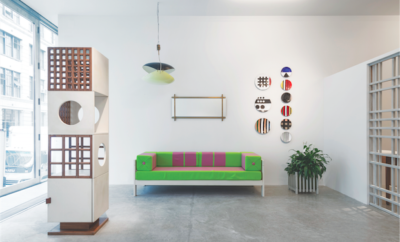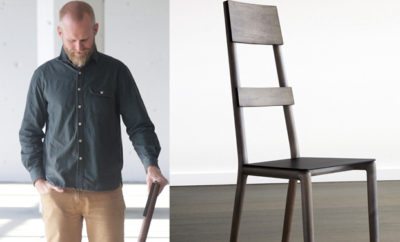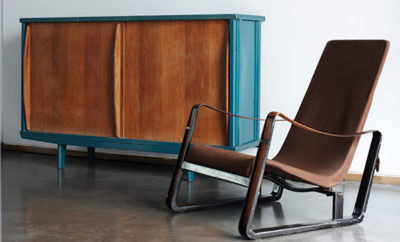 Cascades of glass beads form the shades on a pair of silvered-metal sconces by André Groult, c. 1922. Courtesy of Galerie Mathivet.
Cascades of glass beads form the shades on a pair of silvered-metal sconces by André Groult, c. 1922. Courtesy of Galerie Mathivet.
Design
The Enduring Appeal of Art Deco
A heightened interest in art deco design is taking hold these days, say a number of dealers. “As today’s collectors see art deco as the precursor of modern design, that element of historical importance makes for enormous appeal,” explains Fabien Mathivet, whose eponymous gallery is located on the Left Bank in Paris. Susan Weber, founder and director of the Bard Graduate Center in New York, says the style resonates on multiple levels. “The pared down silhouettes, luxurious materials, and sophisticated palettes of art deco continue to exert influence in the collector’s market, in museums, and in popular culture,” she notes. Weber cites such exhibitions as Bard’s An American Style: Global Sources for New York Textile and Fashion Design, 1925–1928, and the Centre Pompidou’s Eileen Gray, as well as last year’s remake of The Great Gatsby as reflecting the “enduring influence of this style.”

Commode in amaranth wood with lapis–lazuli inlay and silvered-metal handles by Marcel Charles Coard, designed 1928–1929. Courtesy of Galerie Marcilhac.
One index of soaring prices for art deco in the auction world is Eileen Gray’s Fauteuil aux Dragons of about 1917, which climbed to an astonishing $28 million-plus at the Christie’s Yves St. Laurent and Pierre Bergé sale on February 23, 2009. That record price remains unbroken, but there have been some other hefty sales. At Christie’s auction of Steven A. Greenberg’s holdings, on December 12, 2012, a Jean Dunand vase of lacquered metal inlaid with eggshell from about 1925 went for $902,500 against an estimate of $150,000 to $200,000. Most recently, at Sotheby’s Paris sale of Félix Marcilhac’s private collection on March 11 of this year, a 1924 Pierre Legrain nickel-plated brass and glass console far surpassed its $139,000 to $167,000 estimate and climbed to $852,790.
“L’Exposition internationale des arts décoratifs et industriels moderns, which was held here in Paris in 1925 had a profound effect on design” says Fabien Mathivet. “A stunning sixteen million visitors took in that exposition—whose name gave rise to the term art deco—to see outstanding examples from the period.” At this fall’s Paris Biennale, Mathivet showcased a rare 1925 circular Émile-Jacques Ruhlmann rug with a beige background and a design of rose rosettes along with a pair of 1922 André Groult silvered-brass sconces with cascades of glass beads as shades. Interior designers Jacques Grange, David Kleinberg, and Tony Ingrao frequently acquire art deco design from Mathivet.
Another Biennale participant, Galerie Marcilhac, also on the Left Bank, likewise specializes in deco. “Both new and seasoned collectors are drawn to the highly refined craftsmanship,” Félix Marcilhac says. He cites a commode by Marcel Charles Coard in amaranth wood with lapis-lazuli inlay and silvered-metal handles as a fine example. Another is Oiseaux Exotique, a 1928 Jean Dunand and Jean Lambert Rucki lacquered screen inset with painted silk panels. “As demand for art deco design has doubled in the past five years, sourcing masterpieces is increasingly difficult,” he says. He has a waiting list for pieces by Ruhlmann.
The steady stream of interior designers seeking out Marcilhac include François-Joseph Graf, François Catroux, and William Sofield. As for other fairs, Marcilhac will take part in PAD London and Salon: Art and Design in New York.

Silver tea and coffee service made by Roberts and Belk, Sheffield, England, 1932–1936. Courtesy of Koopman Rare Art.
Lewis Smith, who serves as director of Koopman Rare Art in London, is witnessing widespread interest in art deco silver. “Our market is truly international with clients from America, South America, Europe, Asia, the Middle East, South Africa, and Australia,” says Smith, whose fair roster includes the Haughton International Fine Art and Antique Dealers Show in New York in October, TEFAF, Masterpiece London, and the Fine Art Asia fair in Hong Kong. Certain to be snapped up is a George V tea and coffee service made in Sheffield in the 1930s by Roberts and Belk.
Specializing in period silver and design, Michael James who founded the Silver Fund, also in London, has opened a 2,500-square-foot gallery in Palm Beach. In addition to period silver, he now carries art deco furniture and lighting. “Because the 1920s were really the beginning of a kind of minimalism, as the designs were linear and the decoration pared down, more contemporary art and design collectors are requesting Jean Puiforcat and Georg Jensen silver,” James says. He cites Harald Nielsen’s iconic 1930 Dolphin Pyramid pattern fish dishes with covers, which were designed for Jensen, as highly sought.
Architect Peter Marino and interior designers Juan Montoya and Jamie Drake routinely purchase deco silver from James. He participates in the October Haughton show as well as the American International Fine Art Fair in Palm Beach, Masterpiece London, and others.

This is the only known example of this Émile- Jacques Ruhlmann armchair, documented in a studio photograph of c. 1922. Coutesy of Calderwood Gallery.
Gary Calderwood launched the Calderwood Gallery in Philadelphia in 1982 and today has thirty thousand square feet in the downtown area devoted to art deco. He says collectors especially prize examples that were included in the 1925 Paris exposition, such as an amboyna wood piano designed by Maurice Dufrène that was showcased at the fair. “With its sleek lines, the piano is a work of sculpture in its own right,” Calderwood says, adding, “we also have the original studio photograph of the piano.” Another important piece at Calderwood is a mahogany Ruhlmann armchair with an oval back and faceted legs tapered at the bottom. “It is the only known example of that model,” Calderwood says.
Calderwood does not participate in any fairs—the core of his business is with architects and interior designers internationally. “We even have designers from Japan as clients,” he says.
Longtime dealer in art deco and modernism Ric Emmett of the Modernism Gallery was forced to close his Coral Gables, Florida, premises due to a fire in 2004, but has been operating privately and online since. He has just opened a Miami premises where he sees even more clients drawn to art deco design. “Clients appreciate the grain of the wood and lacquer as well as the element of historical importance,” he notes. Currently, he has a group of graphics related to the 1925 exposition, including the poster shown here, by Robert Bonfils (the entire set is $75,000). With a growing number of collectors, demand for quality has more than tripled, Emmett reports. “Prices currently are more than double what they were before the recession.” Emmett has sold examples to the Metropolitan Museum of Art and the Museum of Fine Arts, Boston.

Colorful birds are enameled over a copper base on this c. 1930 vase signed by Camille Fauré. Courtesy of Valerio Art Deco.
Nearby in Coral Gables, Valerio Art Deco has been in business since 1982. Waltford Gonzalez, who serves as gallery director, reports their clientele has grown far more international and now includes South Americans, Russians, and Chinese. “Clients are attracted to the exotic materials like amboyna and shagreen along with French glass and fine enamel work,” he says. Gonzalez points to a 1925 Edgar Brandt gilt-bronze table lamp with a Daum shade as certain to find favor. “A similar example was in the Yves St. Laurent sale,” he notes. Frequently requested are vases and table lamps by Camille Fauré. “A classic example is a Fauré vase from about 1930 with a design of birds in hand-applied enamel over a copper base.”
On the Upper East Side of Manhattan, Tony DeLorenzo’s DeLorenzo Gallery has long been a pacesetter when it comes to art deco. Located for many years on Madison Avenue, the gallery moved to a new location on East 76th Street in September. Adriana Friedman, DeLorenzo’s director, says the deco period “demanded linear, non-constructive design, different from the previous art nouveau era.” She refers to a pair of Pierre Chareau wall sconces as “totally minimalist,” juxtaposing hand-hammered iron plates with alabaster block shades. “There was not only innovation in design, but also in the use of disparate fine materials that, when used together, provided profound aesthetic innovation.” In that regard Friedman cites a Marcel Coard cabinet that incorporates shagreen, lapis lazuli, lacquer, and macassar ebony all in one piece. The gallery will offer a Ruhlmann prototype chair of lacquered metal from Michael Chow’s collection at Salon: Art and Design in November. Samuel Amoia, who will be designing their stand at the fair, is just one of many designers plucking up art deco pieces at DeLorenzo.

Gio Ponti designed this mirror hand blown by Venini. Courtesy of R. Louis Bofferding Decorative and Fine Art.
R. Louis Bofferding Decorative and Fine Art, also on the Upper East Side, focuses on design from the 1920s through the 1960s. Just this summer, Bofferding sold the rare 1928 Gio Ponti mirror shown above. “Hand-blown by Venini, the mirror was made for the 1928 Venice Biennale,” Bofferding says, adding that it is the only one known to survive. Currently, he is offering an orange Venini glass bowl of about 1928.
Bofferding’s A-list clientele includes figures as diverse as interior designers Jacques Grange, Alex Papachristidis, and Mario Buatta along with fashion designer Valentino, art dealer Matthew Marks, and art consultant Tobias Meyer.
Private New York dealer Dr. Stephen E. Kelly, whose Kelly Gallery specializes in 1920s and 1930s design, says the global market for pre-1900 antiques is “past its prime.” “Decorative arts from the 1920s work well in contemporary interiors and also with twentieth-century fine art like Mark Rothko and Franz Kline,” he notes. He is currently featuring an Eileen Gray lacquered screen of about 1922. Among the ceramics he has on exhibit is a 1923 Henri Simmen and Eugenie O’Kin miniature stoneware jar in deep blue with a carved ivory top, from the collection of Karl Lagerfeld. Kelly’s clients hail from Europe, Australia, and Hong Kong.

Pierre Chareau’s model MT344 stools of 1926 are fashioned in wrought iron and mahogany. Courtesy of Maison Gerard.
In Greenwich Village Maison Gerard has long attracted art deco enthusiasts. Of particular note is a 1926 Jules Leleu amboyna barbière, or shaving stand, with nickeled-bronze fittings. “It was designed for the family of filmmaker Louis Malle,” says gallery partner Benoist Drut. “With its spare, elongated design and distinguished provenance, it is bound to be snapped up quickly.” Also of interest is a pair of 1926 Pierre Chareau mahogany and wrought-iron stools marked by spare lines and a total lack of ornamentation. On Drut’s fair roster is the Haughton International show, the Winter Antiques Show, and the Collective Design Fair, all in New York. Designers who are clients include Thad Hayes, Michael Smith, and Brian McCarthy.

Reneé Lalique’s Stockholm III is one of the four Stockholm chandeliers introduced in 1927. Courtesy of Paul Stamati Gallery.
The Paul Stamati Gallery in Long Island City, New York, specializes in period Lalique glass and art deco furniture, with the largest selection of Lalique glass in the world. A starlike 1927 Lalique Stockholm III chandelier is tagged at $60,000. “As the techniques required in producing Lalique glass are so complex and the machinery so heavy, there are no fakes on the market,” Stamati says. Among his art deco furnishings is a 1920 Raymond Subes console in wrought iron for $12,500. Designers favoring examples from Stamati include Robert Couturier and David Kleinberg.
In Los Angeles, Morateur Gallery pulls in such clients as fashion designer Tom Ford and architect Peter Marino, among others. Philippe Morateur opened his gallery in Paris in 1991 and moved to L.A. in 2009. Currently he has on display a set of six large Ruhlmann etched and gilded-glass panels, never seen outside of Paris before. They’re from the historic Parisian restaurant Drouant, for which Ruhlmann designed the entire interior in 1924. Also certain to spark interest is a 1935 Eugène Printz palm wood and oxidized-brass desk with curvilinear brass legs. “It’s exceedingly rare, perhaps one of only three,” Morateur says. In addition, he has a circa 1925 Albert Cheuret patinated bronze clock with an alabaster face and a silver key.
He has sold to such prestigious institutions as the Musée des Années 30 in Paris. He says interest in design by the masters of art deco has never declined. “As the taste for art deco endures, the value will never be diminished,” he adds, noting that art deco pieces mix well with both modern and contemporary design.
“The twenties design style is timeless,” Adriana Friedman concurs. “The streamlining of design coupled with the richness of the materials and fine craftsmanship in deco makes it the perfect counterpoint to a range of design and fine art today,” Kelly adds.












